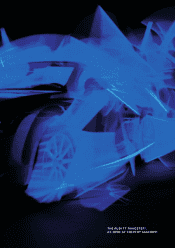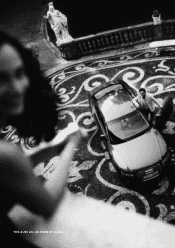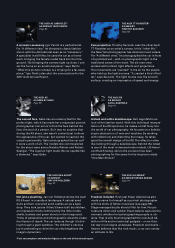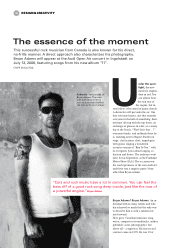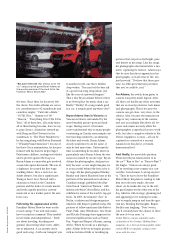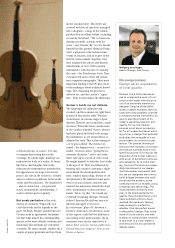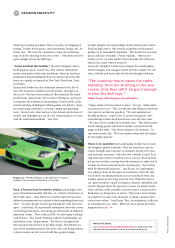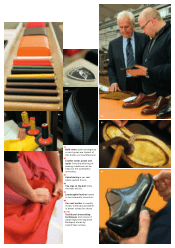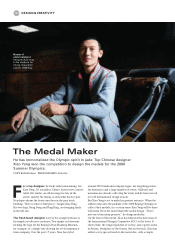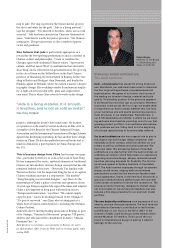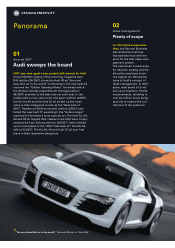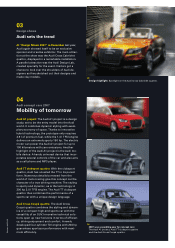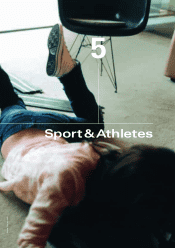Audi 2007 Annual Report Download - page 101
Download and view the complete annual report
Please find page 101 of the 2007 Audi annual report below. You can navigate through the pages in the report by either clicking on the pages listed below, or by using the keyword search tool below to find specific information within the annual report.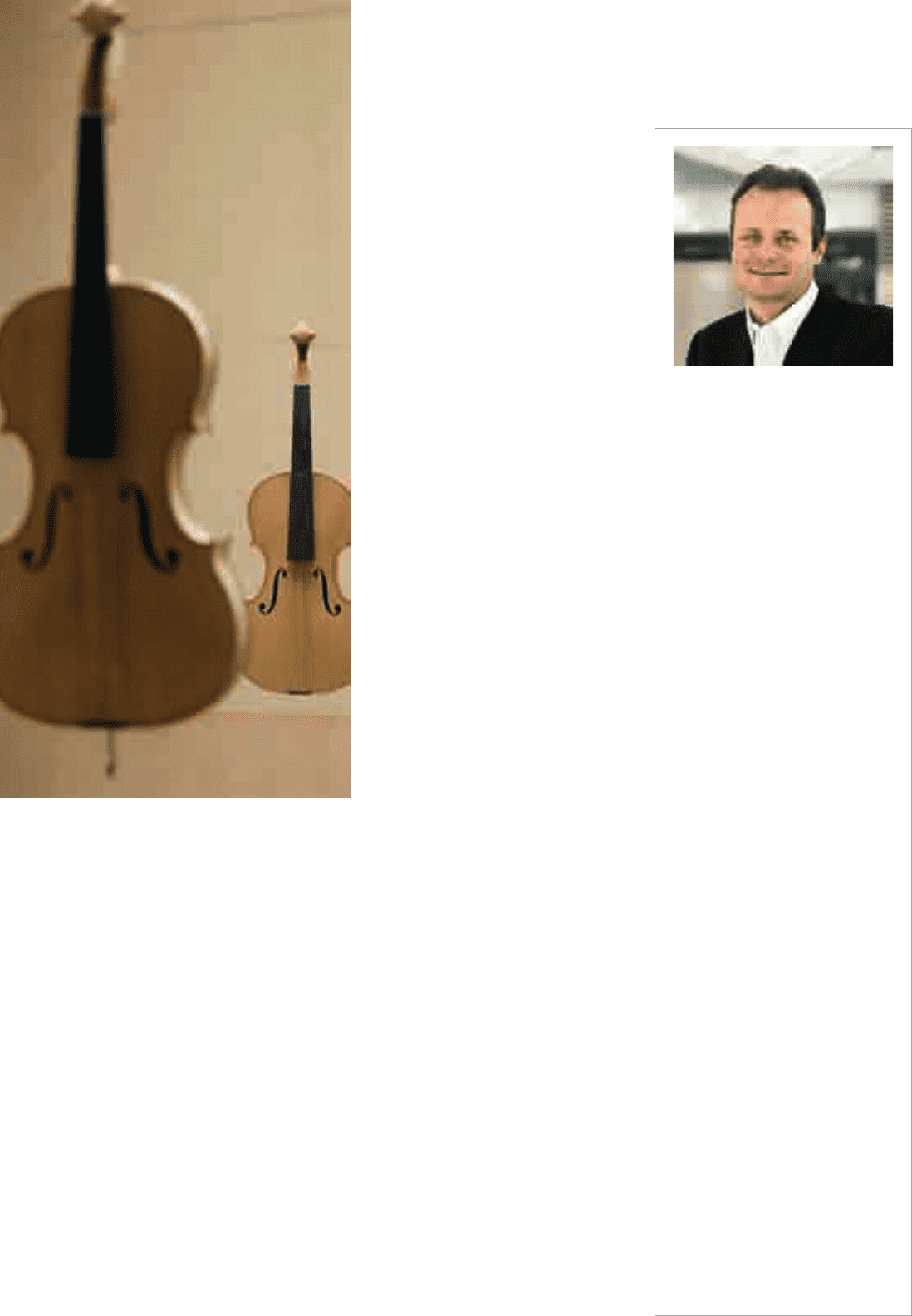
a stylish old cup, of course. It is easy
to imagine him sitting here in the
evenings, by candle light, daubing var-
nish onto the body of a violin. At times
like these, his thoughts turn to the
musician the instrument is intended for,
his appearances on stage, his favorite
pieces, his role in the orchestra. Greiner
aims to achieve a symbiosis between the
violin and the musician. “He should feel
– and of course hear – my personal
touch, my personal craftsmanship. I
want to deliver perfect quality.”
But surely perfection is the arch-
enemy of creativity? Especially in a
craft that feeds on the legends of the
past? On Bach, Mozart and Beethoven?
Greiner nods in agreement, but points
out that what makes his craftsmanship
special is the way it blends tradition and
modernity. His methods are extremely
scientific. He turns around, reaches for a
couple of paper printouts and lays them
on the wooden table. The sheets are
covered with lots of tiny dots, arranged
into a diagram – a map of the sounds
produced by excellent violins, including
several by Stradivari. “We’ve been con-
ducting scientific acoustic tests for
years,” says Greiner. By “we” he means
himself and his partner Heinrich Dünn-
wald, a physicist at the technical uni-
versity in Aachen, and an expert in the
field of violin sounds. Together, they
have analyzed the curves and density
distributions of over 1,000 wooden
instruments, with the aim of cracking
the code – the Stradivarius Code. They
even inserted some of the old violins
into computer tomographs. Their most
important finding is that 90 percent of
violin making is about technical knowl-
edge. The remaining ten percent is
down to art, and the creator’s “signa-
ture.”That is what makes the difference.
Greiner’s hands are not delicate.
The fingertips are calloused and
cracked, and the reasons are right there
in front of him on the table: Wooden
violin forms, in various stages of pro-
duction. Then he carves and files, sands
and saws. When the basic construction
of the violin is finished, that is, when it
has been glued and fitted with strings,
the instrument, as yet unvarnished, is
adjusted for tone. This is fine-tuning of
a very special kind. The essence of
sound – the human voice – is used as a
model. Greiner calls it “giving the in-
strument character,” and it can some-
times take up to a week of extra work.
He taught himself to build his first violin
at the age of 14. That was followed by
training and a master craftsman’s diplo-
ma in Bonn. He developed his own
style, studied musicology, history of art
and phonetics. He tinkered some more,
went to classical music concerts and
waylaid the musicians outside the stage
door, thrusting his violins into their
hands. “Here, try this,” he would say,
eventually breaking through. German
soloist Christian Tetzlaff was one vio-
linist he managed to win over.
In a television “play-off” between a
Greiner violin and a Stradivarius, none
of the experts could tell the difference.
According to the professionals, the in-
struments were on the same level. •
Robert Kittel writes for German publications
GQ and brand eins magazine, Stern.de and
Wiener of Austria.
No compromises:
Design as an expression
of total quality
Wolfgang Josef Egger,
Head of Design, Audi Group.
Perhaps it is a little presumptu-
ous to compare the work of a vir-
tuoso violin maker with the prod-
uct of an extremely creative car
designer. Despite all the differ-
ences in detail, however, there ac-
tually are a few parallels. Just like
a valuable musical instrument, an
Audi is also the product of its
maker’s supreme precision and
quality. For us, the creative
process is not about producing
art for art’s sake, but about creat-
ing a form, a design that perfectly
embodies the strengths of a car
and projects its contours to per-
fection. The precise drawing of
lines and the interplay of concave
and convex surfaces have a very
specific purpose: To bring out the
character of the model, bestow it
with an air of dynamism and pow-
erful elegance. As in violin mak-
ing, form and function are insepa-
rably intertwined in car design.
Just like master instrument mak-
ers, we car designers also aim to
build bridges between the tradi-
tional and the modern, as we
carefully evolve our models using
contemporary technology. The
most dramatic similarity, how-
ever, is the absolute desire for
quality, the principle that you are
never satisfied until you have
reached the optimum. Always
keep looking for perfection,
whether it be the perfect sound
or the perfect design: That is the
mark of a true creator, one who
accepts no compromises. And this
is true both in a violin maker’s
workshop and in an automotive
design studio.
Photo: AUDI AG


